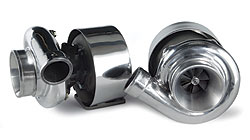Twin-Turbo V8 Facts of Life
Few People Have Ever Experienced Really High Horsepower.
Have you ever ridden in a vehicle powered by a properly engineered twin-turbo V8? No, a single-turbo V8, or heaven forbid, a single-turbo four cylinder is not the same thing, not even close.
We’ve all heard the wisdom that there’s no substitute for cubic inches, but cubic inches of what? Is it cubic inches of engine that count, or cubic inches of air in the combustion chamber? It’s obviously the latter. So consider this, 15 psi of boost effectively doubles the size of an engine. That means 15 psi of boost will make a 350-cubic-inch performance engine seem like a 700-cubic-inch performance engine!
Actually, this picture isn’t accurate. If you understand engines, you’ll immediately realize that 15-psi boost more than doubles the performance an engine. It does this for two reasons: first, the internal friction of the engine remains largely the same regardless of boost, so the extra power from turbocharging is almost totally available to power the vehicle; and second, the 15 psi of boost in the induction system actually helps push the pistons down on the intake stroke whereas the intake stroke created a pumping loss (negative torque) when the engine was normally aspirated.
Now you may be thinking that the turbochargers create exhaust backpressure that increases the pumping loss on the exhaust stroke, but let’s go back to the first sentence of this discussion — we’re talking about a “properly engineered” system. That means the exhaust restriction created by the dual turbos will be minor, and that boost pressure will always exceed exhaust system backpressure. Simply translated, in terms of performance, a good twin-turbo 350 V8 will turn your inside out!
Okay, just for fun, let’s compare our 350 twin-turbo V8 at 15-psi boost to a 120-cubic-inch compact four cylinder running 30 psi of boost — twice that of the V8. By our rule of thumb, the little four-banger will now be flowing air equivalent to a 360-cubic-inch normally aspirated engine. That’s impressive for a small engine, but it will still have only half the power potential of our twin-turbo V8 running at half the boost. If you push the V8 to 30-psi boost, you’ll have the equivalent of 1050 cubic inches and over 1500 hp, if it is done correctly.
By now you get the point. Bigger engines add power, but turbocharging bigger engines really gets the job done. Happily, there’s more good news associated with turbocharging the small-block Chevy V8, and almost all of it comes down to durability. To begin, the performance industry offers a variety of high-strength cylinder blocks in both iron and aluminum. Thicker main webs and four-bolt main caps are just what a turbocharged engine needs. Next, the small-block Chevy uses five head bolts or studs surrounding each cylinder to help secure head gaskets. And of course, the aftermarket has a variety of premium head gaskets too. Then there are other heavy-duty parts readily available, such as forged crankshafts, forged connecting rods, forged pistons, special piston pins, and premium rings and bearings.
Finding all of these things is difficult for other engines, especially for four-cylinder engines.
Of course, the small-block Chevy V8 also benefits from a wide variety of high-performance cylinder heads, intake manifolds, and valvetrain pieces. Simply stated, nearly everything that improves airflow on a normally aspirated engine will also improve total flow on a turbocharged engine.
The next good news is that extreme duty drivetrain parts are readily available for rear-wheel-drive vehicles with V8 engines. This includes clutches, transmissions, u-joints, differentials and axles. Most of this was developed for drag racing or circle track racing. Such strength and durability is important when dealing with real power. For example, a 350-cubic-inch V8 running at 20-psi boost is capable of roughly 900 lb-ft of torque! You don’t feed that through a front-wheel drive transaxle to high-traction tires — at least not more than once.
Turbocharging is fun. It’s addictive. How much power can you make?
There are always big-block engines to consider, and in fact, Banks is developing a drag car with a 526-cubic-inch engine with four turbochargers. Admittedly, such an engine stretches the bounds of credibility. It would seem like that is the ultimate, but there’s another entire chapter to turbocharging that’s just being opened. Can you say diesels at 150-psi boost? Don’t blink. They’re not coming … they’re already here!

Have a SBC project that could use a huge boost in performance?
Click here for more information »

